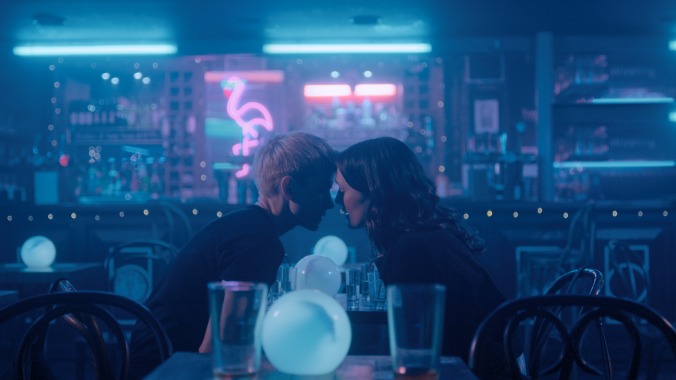Netflix’s Feel Good has more depth and hilarity than a feel-good story

Feel Good, the new Netflix comedy created by and starring Canadian comedian Mae Martin, throws itself into addiction of varying degrees and behaviors. It’s thoughtful and empathetic in its portrayal of protagonist Mae—who, like her portrayer, is a stand-up comedian—as she navigates life as a recovering coke addict. Along the way, the series touches on sexuality, gender, and behavioral addictions that are less obvious, including the complicated and messy concept of love addiction. It doesn’t pathologize its characters, but rather burrows into uncomfortable, deeply human places within relationships.
At the start, Mae enters a relationship with George (Charlotte Ritchie), a woman who has only ever previously dated men. A pressing tension arises when it becomes clear that George doesn’t want to come out to her friends and even goes so far as to make up an imaginary boyfriend for them. This behavior certainly hurts Mae, but there’s the added complication that Mae has a bit of a history with dating women who previously identified as straight; Mae’s mother (Lisa Kudrow, in a performance that’s equally acidic and hilarious) claims that her daughter gets off on the chase. Mae and George both have a ton of baggage that creates stark—and sometimes contradictory—power imbalances in their relationship. Feel Good captures the slightly weird, adorable, specific sweet moments of a budding romance with as much depth and beauty as it does the messy, hard parts. Like Mae’s stand-up sets on the show, it sharply mines discomfort for humor.
Much more than just a show about modern dating, Feel Good looks at all kinds of relationships: fractured ones, blooming ones, evolving ones. It grapples with the difficult relationship between Mae and her parents, who kicked her out when she was a teenager, as well as the relationship between another mother and daughter as they attempt to repair the damage done by addiction. It takes on George’s relationships with her friends, from whom she hides such a major part of her life; she gradually realizes she’s just spent a lot of time with them instead of forging some genuine connections. The arc of George and Mae’s relationship is, like a real-life relationship, intoxicating at the start and then gradually punctured by conflict, and it’s told with an impressive amount of detail and complexity in just six short episodes.
The show is also deeply queer, not only in the sense that it centers on queer characters, but also in the way those characters specifically have been written. Its strap-on-centric portrayal of lesbian sex is something rarely seen on television, even in both iterations of The L Word, which feature so many instances of lesbian sex but rarely strap-ons or toys of any kind (and yes, there is one requisite and perfect L Word joke in Feel Good). Feel Good is also directed by out director Ally Pankiw, and any time LGBTQ+ stories are told by LGBTQ+ artists, it deepens authenticity in certain areas. “I’m feeling bad about my gender,” Mae says in one scene, a simple line that succinctly emphasizes that neither gender nor one’s relation to it are fixed.
The casual homophobia among George’s friend group is similarly very convincing, an honest portrayal of the ways people socially reinforce heteronormativity without even realizing it. Her friends are assholes, and George becomes an asshole around them. But the most striking thing about Feel Good is how it simultaneously scrutinizes and empathizes with its characters. It’s a deeply intimate show, and this means seeing people’s flaws in a clear light. Mae is often affronted by others’ assumptions and judgments of her as an addict and also as a masculine-of-center person. But she hurts others along the way, messing things up royally with one of her truest friends and working out some of her deepest insecurities on the stage in a way that rightfully upsets George. Feel Good allows room for mistakes and also growth. Its empathy stands out.
Feel Good manages to do all this intricate story work about gender, sexuality, addiction, and relationships while establishing a clear comedic voice right from the start. It’s often very weird, bordering on the surreal. It takes some sitcom tropes and warps them, like the “bad roommate,” here rendered as Phil, a little like Bevers of Broad City but with much kinder intentions (when he tries to cheer George up about heartbreak, he goes out to buy her a puppy but instead ends up buying her a bucket of worms). There’s also the “zany friend,” depicted here as a fellow recovering addict and fireball of a human. The characters who would normally be at the forefront—like the two white, straight-dude comedian bros Mae does shows with—become flatly portrayed bit characters.
Every detail down to the sound—the same sound effect is used repeatedly to place us in Mae’s head—works toward making Feel Good come to life as a fully realized, specific world that blends surreality with intense reality. The show juxtaposes self-destruction with happiness, suggesting that a quest for the latter can often entail the former. It doesn’t always feel good to watch it, but that’s part of Feel Good’s magic. It tells a story full of discomfort and insecurity with self-assuredness, empathy, and charm.